2020 marks the 100th anniversary of the founding of Boxoffice Pro. Though the publication you hold in your hands has had different owners, headquarters, and even names—it was founded in Kansas City by 18-year-old Ben Shlyen as The Reel Journal, then called Boxoffice in 1933, and more recently Boxoffice Pro—it has always remained committed to theatrical exhibition.
From the 1920s to the 2020s, Boxoffice Pro has always had one goal: to provide knowledge and insight to those who bring movies to the public. Radio, TV, home video, and streaming have all been perceived as threats to the theatrical exhibition industry over the years, but movie theaters are still here—and so are we.
We at Boxoffice Pro are devotees of the exhibition industry, so we couldn’t resist the excuse of a centennial to explore our archives. What we found was not just the story of a magazine, but the story of an industry—the debates, the innovations, the concerns, and above all the beloved movies. We’ll share our findings in our year-long series, A Century in Exhibition.
When moviegoers sank into their seats in the dark auditorium of the Lowe’s State Theatre in New York City on March 14, 1972, to watch a drama about the Italian American Mafia, little did they know they were making movie history. The Godfather became the best-selling title of the year and the first American film to gross $100 million domestically in its initial release. The Godfather was also making history in a different way: It encapsulated the contradictions of the decade. On the one hand, director Francis Ford Coppola represented the generation of “movie brats,” young male directors fresh out of film school like Martin Scorsese, Brian De Palma, and George Lucas, who represented New Hollywood at its peak. On the other hand, The Godfather was a precursor of the blockbuster phenomenon that buried New Hollywood in the second half of the decade. Like the countercultural revolution that had been embraced by so many young people in the previous decade, The Godfather spoke to the disillusionment of the Vietnam and Watergate era. But in other ways it was a nostalgic film about the waning of white male patriarchal power amid the ascendance of the women’s rights, gay rights, and Black Power movements.
The 1970s were, in fact, a period of rapid and contradictory transformations for exhibition. At the beginning of the decade, weekly admissions continued their decline. Admissions in 1970 were 18 million, down from 30 million in 1960, in part because of rising ticket costs, cable TV, theaters playing the same film for an extended period (a practice Boxoffice Pro founder and editor Ben Shlyen criticized), and a lack of both film variety and advertising. Dwindling admissions and the collapse of the studio system made room for New Hollywood but also for cheap, shocking exploitation films. The civil rights movement and the realization that African American audiences had box office potential launched blaxploitation, while the failures of the MPAA’s rating system opened the door for raunchy sexploitation. Though not without some success, these films were not enough to prevent the downtown houses and movie palaces that showed them from going quiet as (white) audiences and exhibitors rushed to theaters in suburban malls. Movies became another expression of consumerism, epitomized by the rise of blockbusters—with their wider releases and expensive marketing strategies— ushering in an era of new vitality for the industry.
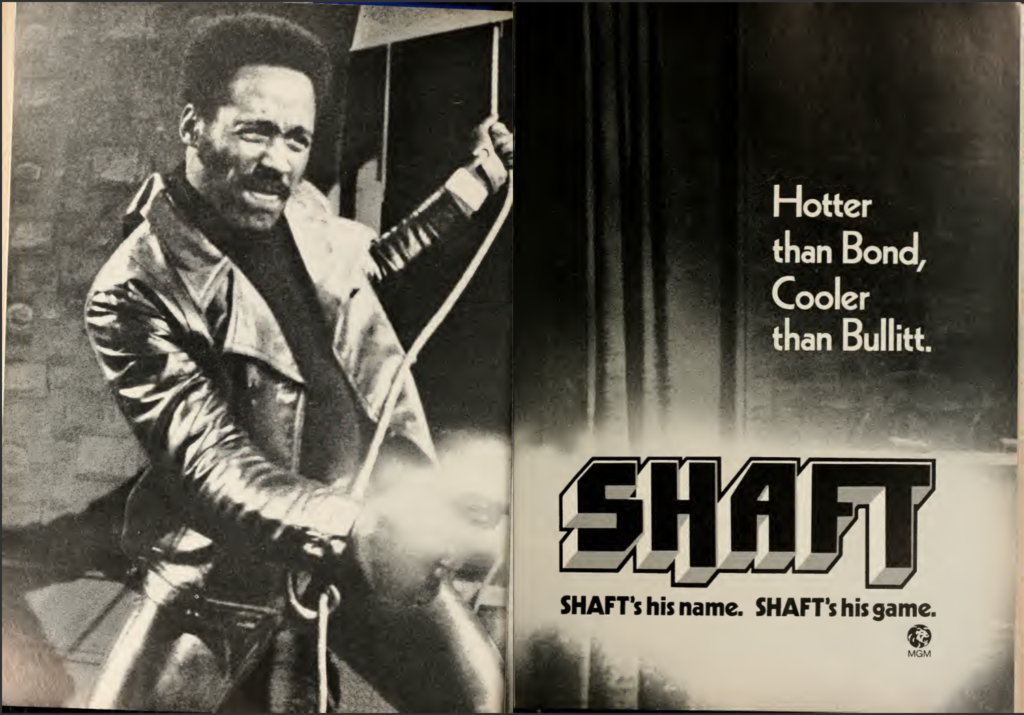
Power to New Audiences
The early 1970s saw an industry in crisis. And as many industries in crisis do, the film industry sought to make money cheaply and quickly. With exploitation films, dabbling in on-trend subjects like martial arts and eroticism, studios were able to attract moviegoers without investing in the sort of big-budget spectacle that had flopped in the 1960s. One of the most important exploitation sub-genres was blaxploitation. The civil rights movement had obliged exhibitors to open their doors to Black audiences and brought new ways of thinking about race relations. For the first time since the birth of cinema, the integration of theaters gave African Americans a wider platform and showed the importance of catering to a diverse audience.
Melvin Van Peebles’s 1971 film Sweet Sweetback’s Baadasssss Song is believed to be the first blaxploitation film. The movie features a male prostitute, Sweetback, who evades the police and protests against white authority. It established one of the genres core themes: A Black person fights the system, and for the first time wins. Despite its X rating (the movie tagline was “X-rated by an all-white jury”), the film grossed $15 million and pushed Hollywood toward a new audience. That same year, MGM’s Shaft became an instant hit. Boxoffice Pro reported that it played 24 hours a day for the first week of its opening in some theaters, like the DeMille Theatre in New York City’s Times Square. Unlike many Hollywood films, the genre also made room for women stars, such as icon Pam Grier, “the “Queen of Blaxploitation.”
Film historians still try to understand the significance and impact of the genre. Was it an expression of Black empowerment, a manifestation of their anger toward the system, or just a new marketing angle for Hollywood? Blaxploitation was indeed criticized by some African Americans and by the NAACP for perpetuating stereotypical images of Black people as criminals. Others criticized the lack of originality of the genre, which by the middle of the decade had resorted to horror, western, and kung fu film remakes.
In the pages of Boxoffice Pro, blaxploitation films were received with mixed reviews. Steven Jacobson, head of the independent production company Xanadu Productions, acknowledged in November 1975 that “Black films make money.” But, criticizing their hyper-focus on Black audiences, he continued that “it’s in the best interest of the industry to be sensitive to the needs of the [entire] moviegoing public.” A semiretired trade paper editor, Don Carle Gillette, criticized their quality. “Too many exhibitors still are more interested in making money from sales of popcorn, cold drinks, and hot dogs than from the sale of box office tickets. … But tawdry exploitation pictures can draw many munchers while quality films attract a more discriminating clientele that sits attentively all through a performance. … So what’s best for the industry—quality films or popcorn pictures?” he asked.
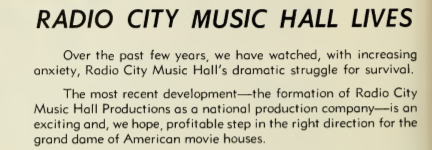
Downtown Theaters Are Shuttered
Criticism aside, blaxploitation films did invigorate Black filmmakers and audiences, especially urban moviegoers. But their success was not enough to keep inner-city theaters from closing. In the local news sections of Boxoffice Pro, articles about theater closings proliferated. In an article dated February 1976, Shlyen attributed this to “conditions which [small theaters] have been unable to control,” including product shortages, excessive rental terms, and extended runs in inner-city theaters that “did not provide sufficient patrons to sustain such extended needs.” Moreover, as an anonymous contributor wrote in 1972, “The audience that once looked to moviegoing big-city wise as a steady habit, has moved increasingly to the outlying sections and spilled over to the fast-growing suburban towns.” Because of the “frightening displays of violence in the streets, choking traffic conditions, [and] reduced parking availability,” they continued, “it’s a matter of persuading entertainment-seekers to ‘return’ to the central-core city after dark.”
Suburbanization was taking a toll on drive-ins too, as more and more were razed to the ground to make room for parking lots and malls. Another institution of American moviegoing was particularly hard hit during that period: movie palaces. A September 1979 editorial entitled “Grand old houses fast becoming a memory” explained that “many of the survivors are threatened with extinction either through demolition, recycling, or restoration projects that would render their once grand appeal antiseptic by former standards of excellence—a sad throwback to the proverbial winds of change that we all so proudly hail as progress.” Boxoffice Pro advocated for the protection of these historically and culturally significant theaters, but the high costs of maintenance in the context of a wider moviegoing crisis made the task almost impossible.
Some movie palaces, like the Hollywood Pantages or Radio City Music Hall, were converted to performing arts centers. Others were transformed into churches. Drive-ins, meanwhile, hosted swap meets to bring in additional revenue during the day. NATO dedicated many conferences and roundtables to the problem, with debates on topics like “Unconventional Uses for Conventional Theaters” or “Daytime Dividends for Drive-ins.” NATO’s 1972 Showmanship Award winner, Joe Vleck, the advertising director of National General Theaters in Los Angeles, suggested making the theaters available for beauty operators’ conventions, travel agencies, garden-equipment dealers, sports-equipment suppliers, and savings and loan shows. In the end, it was grassroots activism from local moviegoers that contributed most to the preservation of movie palaces. Historic theaters like the 4,000-seat Chicago Theatre or the Bandbox in Philadelphia were registered as historical landmarks thanks to their efforts.

Movies Go to the Multiplex
Suburban theaters were popping up just as fast as downtown houses were disappearing. The magazine’s Modern Theater section was continuously dominated by news of the construction of multiplexes, shopping center theaters, and “multi-mini-theaters,” defined as multiplexes with smaller auditoriums. Suburban theaters had their roots in the postwar years, but the 1970s truly became the decade of the “complex theater type,” as M.A. Lightman, president of Malco Theatres, described it in 1970. Shopping center theaters and multiplexes, where exhibitors could show more movies simultaneously to smaller audiences, were now the norm. This coincided with the phenomenon later known as the “malling of America,” a period from 1960 to 1980 in which an estimated 17,500 malls were built. These malls catered to a suburban crowd of largely white, middle class moviegoers—still considered the backbone of the exhibition industry. Far removed from the harsh realities of city life, shopping center theaters were also places where cinema’s escapism could be literally felt.
The multi-theater concept can be attributed to Stanley Durwood, president of Durwood Theatres, the Kansas City–based circuit that eventually became the exhibition giant AMC. After the success of its Parkway Twin in 1962, AMC pioneered the multiplex with the first-ever quadruplex in its hometown in 1966. In April 1971, Boxoffice Pro reported from Kansas City that AMC would open 70 new auditoriums and 17 multiplexes in 13 cities in “one of the most intensive expansions in the history of motion picture exhibition.” AMC’s growth was such that it managed to become a nationwide franchise in less than 10 years. Stanley Durwood described the company’s “fresh and imaginative” approach in a press release: “The patron-oriented convenience, comfort, and choice add up to a totally unique experience that has met with immediate success everywhere it has been introduced.” Durwood also touted the free parking and the availability of “a wide variety of entertainment for a variety of patrons in a single complex.”
Accounts from exhibitors supported Durwood’s argument. The genius of the mall multiplex was that when families were done with their shopping, they could all go to the movies without being obliged to watch the same film. They could go to the theater “together but separately,” wrote one mini-theater exhibitor in 1970. Multiple exhibitors pointed out that the cost of running a multiplex was now about the same as running a single-screen theater with 500 seats or more, thanks to advances in automation, which allowed theaters to serve multiple auditoriums from a single projection booth as well as invest in only one lobby, box office, and concession stand. Ben Shlyen, still urging the protection of smaller urban theaters, congratulated “progressive theatermen for their capacity to innovate and keep up with demographic changes,” as he wrote in 1973. “Competition may come and go, but the movie theater goes on forever. This has been shown in the upbuilding of new theater structures, improvement, and modernization of the existing ones that have kept apace of the demands of the times, population, and urban changes,” he argued.
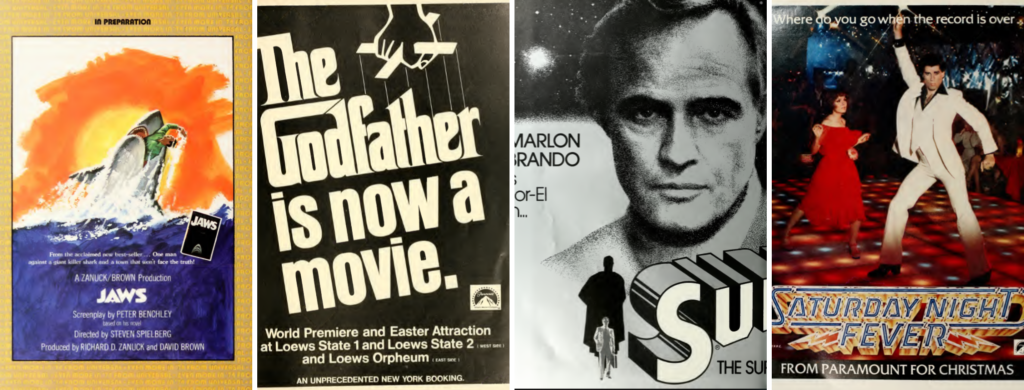
The Blockbuster Phenomenon
With the “malling” of cinemas, movies were now less a cultural form of entertainment than a consumerist hobby. That shift was accelerated and epitomized by the advent of the blockbuster.
After a harsh admissions crisis at the beginning of the decade, “lost” audiences started returning en masse in 1974 when hits like The Exorcist (which broke The Godfather’s box office record) and The Sting contributed to an increase of weekly attendance from 16.6 million in 1973 to 20 million. But the history of the blockbuster cannot be told without Jaws. In 1975, a young director named Steven Spielberg created one of the biggest cultural phenomena in the history of the industry. Jaws became the highest-grossing film ever, as well as the most talked-about movie of the year. The movie was a landmark as well for its unprecedented release: It opened simultaneously in 409 theaters nationwide, while most films until that point would hit screens in a few key locations before rolling into new ones. Jaws was also the first film to understand the power of the ancillary markets. It launched the biggest TV campaign up to then with a $700,000 spend for three nights of nationwide prime time TV ads on all networks. And then came Star Wars (Episode IV – A New Hope). After opening on May 25, 1977, George Lucas’s opus became an instant hit. Its record-breaking success was made evident by the endless lines in front of theaters. “It broke records in every house in which it opened and set cumulative box office records in most of the cities where it is showing,” Boxoffice Pro breathlessly reported on the sixth day of its opening.
Thus was the modern blockbuster born. Bigger, high-concept movies that generated “buzz” started flooding the market. New practices in marketing, wider releases in the summer, and longer runs steadily became the norm. Ben Shlyen pondered the social roots of the phenomenon in January 1979. “Has the public simply tired of the ‘deep think’ and ‘message films’? Some say that the type of pictures America chooses to watch are indicative of what we may be currently experiencing as a people. That is, the recent dramatic shift to the just-for-fun brand of motion pictures is symbolic of what the country is experiencing in the late ’70s. … Today’s audiences are tired of inflation, leery of politics, and are turning to the movies again as a source of entertainment.”
What certainly amplified the escapism and wow effect of blockbusters were their special effects and sound innovations. True to its capitalist foundations, Hollywood seems to follow an economic cycle of booms and busts, the latter often accompanied by surges in technological invention. Much like the gimmick frenzy of the fifties meant to combat TV, the 1970s witnessed a technological boom that was supposed to attract the “lost” audiences flocking to cable and video cassettes. While advances in sound and special effects had been happening for decades, they gained an unprecedented popularity in the 1970s thanks to the blockbuster.
One of those innovations was Imax, which premiered at the Expo ’70 world’s fair in Japan with the 17-minute-long Tiger Child. Special effects also captivated audiences in memorable sequences in films like The Exorcist, Superman: The Movie, and Alien. Star Wars perhaps did more than any other movie to popularize special effects with its first extensive use of animated 3-D CGI, widely lauded in the pages of Boxoffice Pro. The film’s VFX editors, including several of George Lucas’s Industrial Light and Magic co-founders, went on to receive the Academy Award for Best Achievement in Visual Effects.
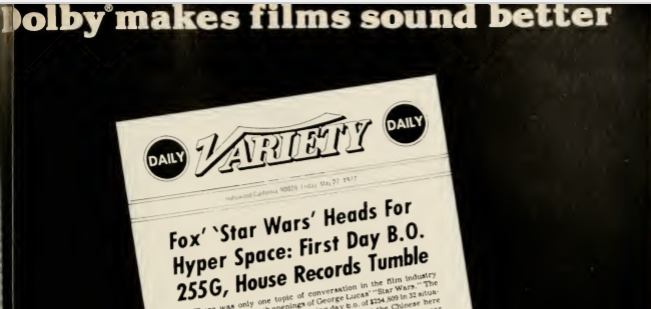
Star Wars also cemented Dolby’s dominance as surround sound made its comeback. In 1971, A Clockwork Orange had become the first film to use Dolby technology for recording sound and noise reduction. Dolby Stereo, an optical four-channel sound system technology, was used in A Star Is Born five years later. But to quote famed sound designer Walter Murch, “Star Wars was the can opener that made people realize not only the effect of sound but the effect that good sound had at the box office.” When Star Wars opened in the summer of 1977, only three prints out of the 40 screens where it played were Dolby. Lucas, despite distributor 20th Century Fox’s objections, had insisted on using Dolby Stereo. As the Star Wars phenomenon took off, so did the demand for Dolby. In the first weeks after the launch of the film, more and more space in the magazine was dedicated to the installation of the system in theaters all over the country. Exhibitors bragged about the modernity of their theaters and the box office effects of the technology. A showman in Louisville was reported as saying that the Dolby system was “excellent, making even regular films sound better.” Another exhibitor in Milwaukee boasted about recently installing the system, “which people tell [him] is half the film.”
Dolby Stereo had become a must. For many, it was the way to fight home entertainment. Dennis Udovic, a Wisconsin projectionist writing to Boxoffice Pro in September 1977, argued, “The basic movie customers are young people, and stereophonic sound is right up their alley.” Two years later, writer John M. Novak urged exhibitors to abandon the view that stereo sound was “just another fad” and advised them to invest in the technology. “The average theater is 30 years behind the times in terms of sound quality. … In competition with the quality of today’s home stereo components, never mind what’s in store for tomorrow; the average theater sound system would lose by forfeit,” he argued.
The blockbusters, in combination with multiplexes and technological innovations, gave new life to the industry and changed it forever. Ben Shlyen wrote in March 1976 that good blockbusters have “caused people, again, to talk enthusiastically about motion pictures.” Nevertheless, as waves of blockbusters overwhelmed theaters, critics—including Shlyen—pointed out that the lack of diversity, embodied by the predictable stories copying the Star Wars and Jaws formulas, coupled with long runs could eventually hurt the market. It was not enough to have big films. They needed to be good as well. Many articles in Boxoffice Pro warned of the importance of protecting smaller, high-quality films. One writer in Knoxville, in a 1976 review of Stanley Kubrick’s Barry Lyndon, declared, “It takes a lot of guts to assemble a film of this magnitude to compete with today’s made-for-money movies.” The exhibition landscape was indeed very different from what it was in the early 1970s, with its independent New Hollywood productions.
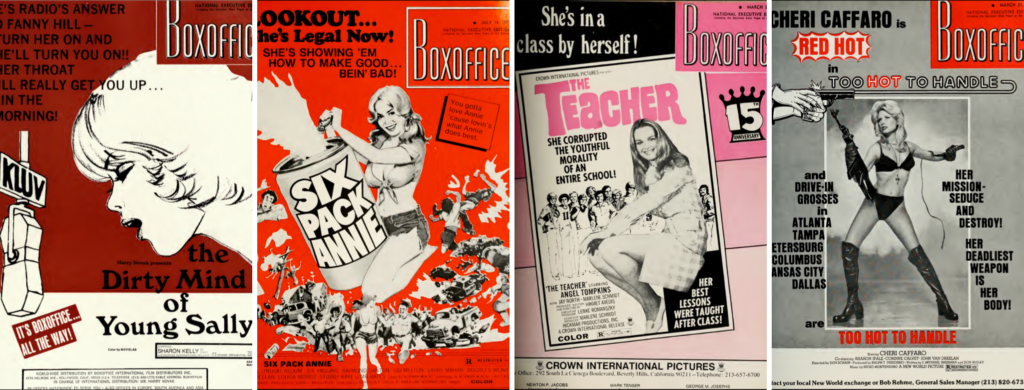
Sex, Censors, and Videotapes
The end of the 1970s was radically different in another respect. The first half of the decade did not only see the height of New Hollywood and blaxploitation—it was the heyday of sexploitation. MPAA president Jack Valenti’s rating system had failed to trademark the X rating, which led to a boom of adult films in downtown theaters. In particular, 1972 and 1973 were the golden age of sexploitation. Deep Throat was mainstream (even Jacqueline Kennedy Onassis saw it, and Bob Hope talked about it on TV), and adult film exhibitors, now organized in their own trade group, the Adult Film Association of America, were preparing their own ratings code.And while Boxoffice Pro frequently wrote about the need for more general and family products, most of the ads in the magazine during that period were for X-rated films.
Sexploitation relaunched debates about censorship and the precise meaning of “obscenity” and “pornography,” which lacked an official legal definition. Roth v. United States had established in 1957 that sex and obscenity were not synonymous but did not define what obscenity actually was. A few years later, an exhibitor from Georgia, Billy Jenkins, was arrested for showing Mike Nichols’s Carnal Knowledge. His case was taken to the Supreme Court, which ruled the movie was not obscene. But in 1973, the Supreme Court found that obscenity should be defined “by contemporary community standards,” leading many local courts to ban erotic films. Adult theaters were subject to crackdowns by the police and picketed by citizens. Some cities even developed zoned areas specifically for adult theaters, as many people feared their effects on children. In fact, another debate frequently animating the magazine was the impact of these movies on the behavior of audiences. Most of the studies presented concluded that pornography had no impact on “moral character and sexual orientation.”
James H. Nicholson, president of American International Pictures, said in a keynote speech at a NATO convention in 1970: “I cannot believe we are all voyeurs, and I know this present ‘flash’ of box office gold is mostly the result of fleeting curiosity.” Looking at the example of Europe, he warned, “The audience who liked the almost pornographic films got tired of them, and the audiences they had alienated no longer cared about going to the movies.” Letters from exhibitors in the magazine certainly show that there was indeed sexploitation fatigue by the mid-1970s. However, it was not the end of that “fleeting curiosity” that killed adult film exhibition. Adult exhibition was an early victim of the industry’s newest threat, video cassettes, which were to become so contentious in the eighties.
The post A Century in Exhibition—The 1970s: A New Hope appeared first on Boxoffice.
from Boxoffice





0 comments:
Post a Comment